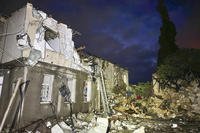ORLANDO -- After sitting on the ground at Eglin Air Force Base in Florida for months, the Pentagon's fleet of F-35 Joint Strike Fighter training jets could beging flying in a matter of weeks, the Air Force's top training officer said Thursday.
"We're not certainly talking months away at this point, it's a matter of weeks in my mind and we'll see how all that comes together," said Gen. Edward Rice, commander of Air Education and Training Command, during a press conference at the Air Force Association's winter conference here.
The jets have been idle since being delivered to the Florida Panhandle base as they await their military flight clearance -- which Rice indicated may come in just a few weeks.
Rice went on to point out that it could be quite a while before student pilots will be allowed to take the birds into the skies. First, the service must ensure that the training plan can actually be put into action. Bascially, the Air Force has to make sure the jets can fly enough sorties to train the pilots.
"What we will do at Eglin is to take a phased approach to executing a formal pilot training syllabus," said Rice. "We'll have a phased that really transitions us from a no fly phase into a place where we're ready to completely test out the syllabus. That phase will be characterized by putting more hours on the aircraft, checking out the individual elements of the syllabus; we'll take off, we'll go out and fly to the [training ranges] and make sure that the communications are working, when we land the aircraft we'll make sure we can get the right maintenance data off the aircraft and send it out through the right communications channels to the right places to order the right parts [making sure] that all of that works in the real world. We've simulated all of that but as you know, the real world is always different than the simulated world."
Yup, the air service is going to have to test the whole F-35 supply chain which involves a host of computerized maintenance diagnostic and parts ordering tools. Basically, a mechanic can plug the jet into a computer and the plane can tell it what parts need to be worked on and even indicated which replacement parts need to be ordered and when.
"We're flying airplanes so we're gonna have to be ordering parts," added Rice.
He declined to set a date by for when Eglin's JSF's will be ready to be flown by large numbers of student pilots; he would only say that he think the process will probably take less than a year.
"We'll start very slowly, a couple of flights a week and we'll ramp that up until I'm satisfied that we can sustain enough of a sortie rate that we can go into the syllabus," said Rice. "We have to make sure that the system matures itself such that we can sustain a sortie rate that will allow us to begin training and I don't know how long that will take. It will take as long as it takes, the good news is that I'm not being pushed by anybody or anything at this point."
"I don't think its a year, but I think from begin to end its more than three months," he added. So, is it larger than a breadbox? Yes. Is it smaller than a Volkswagen? Probably."
Only after the system is validated will student pilots be cleared to slowly begin training in the jet.
"Once I've decided, 'ok, I think we're ready,' we will go through a phase where we'll test the entire syllabus," said Rice. "We'll take students, we'll put them through day one, they'll graduate on day X and we'll run the whole syllabus. If I'm satisfied that yes, all of that has come together and we can train students, then the last phase will be we'll start to train [big groups of] students" to fly the jet.
Remember, F-35 deliveries have been further slowed to allow the program to complete its testing and development phase -- slated to end in 2016 -- before a ton of production aircraft are built. This means the demand for F-35 pilots shouldn't be enormous for the next few years. Still, it will be interesting to see how long it takes for the Eglin planes to begin training pilots once the jets are cleared. Hopefully there will be no major surprises when the service begins to actually test out the supply chain in the real world. We'll see.








